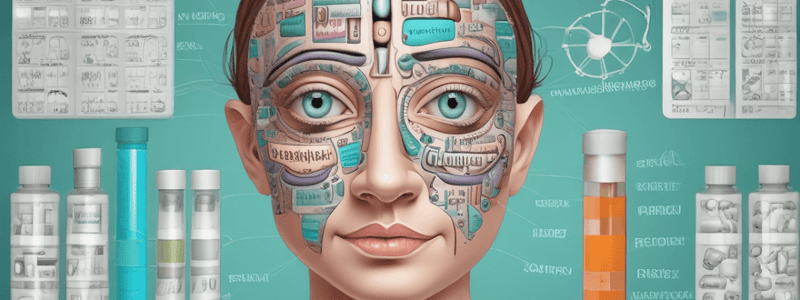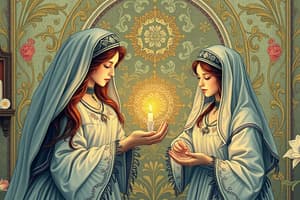Podcast
Questions and Answers
What does 'TIW' abbreviate in a medication prescription?
What does 'TIW' abbreviate in a medication prescription?
- Three times a week (correct)
- Take in water
- Twice a day
- Two in the morning
What is the correct way to write '500 micrograms' in a medication prescription?
What is the correct way to write '500 micrograms' in a medication prescription?
- 500 micro grams
- 500.0 ug
- 500 μg
- 500 mcg (correct)
What should be used only for emergencies and follow facility protocol?
What should be used only for emergencies and follow facility protocol?
- Verbal prescriptions
- Electronic prescriptions
- Written prescriptions
- Telephone prescriptions (correct)
What does 'HS' abbreviate in a medication prescription?
What does 'HS' abbreviate in a medication prescription?
What is the correct way to write '1.5 milliliters' in a medication prescription?
What is the correct way to write '1.5 milliliters' in a medication prescription?
What is the correct way to write 'greater than' in a medication prescription?
What is the correct way to write 'greater than' in a medication prescription?
What does 'OD' abbreviate in a medication prescription?
What does 'OD' abbreviate in a medication prescription?
What is the correct way to write 'five hundred units' in a medication prescription?
What is the correct way to write 'five hundred units' in a medication prescription?
What happens to a prescription without a termination date?
What happens to a prescription without a termination date?
Why do providers need to re-prescribe certain medications?
Why do providers need to re-prescribe certain medications?
Who writes medication prescriptions on the client's medical record?
Who writes medication prescriptions on the client's medical record?
What is a single or one-time prescription used for?
What is a single or one-time prescription used for?
What is the purpose of transcribing medication prescriptions onto the medication administration record (MAR)?
What is the purpose of transcribing medication prescriptions onto the medication administration record (MAR)?
What happens when a nurse receives a verbal or telephone prescription from a provider?
What happens when a nurse receives a verbal or telephone prescription from a provider?
What is specified by the facility's policy regarding medication prescriptions written by nurses?
What is specified by the facility's policy regarding medication prescriptions written by nurses?
What is an example of a one-time prescription?
What is an example of a one-time prescription?
What is the purpose of reading back a telephone prescription to the provider?
What is the purpose of reading back a telephone prescription to the provider?
What is an acceptable client identifier according to The Joint Commission?
What is an acceptable client identifier according to The Joint Commission?
Why should nurses use aids when taking a telephone prescription?
Why should nurses use aids when taking a telephone prescription?
What is the purpose of verifying a prescription with a second nurse?
What is the purpose of verifying a prescription with a second nurse?
Why is it important to ask clients about allergies during medication administration?
Why is it important to ask clients about allergies during medication administration?
What is the purpose of a Medication Administration Record (MAR)?
What is the purpose of a Medication Administration Record (MAR)?
Why is it important to have a specific timeline for verifying prescriptions?
Why is it important to have a specific timeline for verifying prescriptions?
What is the purpose of using bar-code scanners to identify clients?
What is the purpose of using bar-code scanners to identify clients?
Which of the following medications has a greater risk of misuse and dependence compared to phenobarbital?
Which of the following medications has a greater risk of misuse and dependence compared to phenobarbital?
What is a crucial aspect of a nurse's responsibility during medication administration?
What is a crucial aspect of a nurse's responsibility during medication administration?
What is a critical aspect of a medication's classification?
What is a critical aspect of a medication's classification?
What is a key component of a nurse's knowledge base regarding medications?
What is a key component of a nurse's knowledge base regarding medications?
Why is it essential for nurses to conduct a physical examination before administering medications?
Why is it essential for nurses to conduct a physical examination before administering medications?
Study Notes
Abbreviations and Symbols
- MgSO4: magnesium sulfate
- TIW: 3 times weekly
- HS: hour of sleep or bedtime
- SC/SQ: subcutaneously
- IN: intranasal
- u/IU: units
- μ/mcg: microgram
- x3d: times 3 days
- cc: mL
- &/+: and
- / : per
- AD/AS/AU: right ear, left ear, both ears
- OD/OS/OU: right eye, left eye, both eyes
- D/C: discharge or discontinue
Medication Prescriptions
- Providers must re-prescribe some medications (opioids and antibiotics) within a specific amount of time or they will automatically discontinue
- Medication prescriptions must be written on the client's medical record
- Facility's policy specifies how much time the provider has to sign the prescription
Single or One-Time Prescriptions
- A single or one-time prescription is for administration once at a specific time or as soon as possible
- These prescriptions are common for preoperative or preprocedural medications
Taking a Telephone Prescription
- Only take telephone prescriptions when absolutely necessary
- Ensure the prescription is complete and correct by reading it back to the provider
- Verify the client's name, medication name, dosage, time to give, frequency, and route
- Use aids to ensure correct spelling and state numbers separately
Rights of Safe Medication Administration
- Right client: verify clients' identification before each medication administration using two client identifiers (e.g. name, assigned identification number)
- Right medication: correctly interpret medication prescriptions, verifying completeness and clarity
Medication Nomenclature
- A medication has multiple names: generic, chemical, and trade names.
- Generic name: official or nonproprietary name given by the United States Adopted Names Council (e.g., acetaminophen).
- Chemical name: a medication's chemical composition (e.g., N-acetyl-para-aminophenol).
- Trade name: brand or proprietary name given by the manufacturer (e.g., Tylenol, Tempra).
Toxic Effects and Interactions
- Medications can have specific risks and manifestations of toxicity (e.g., gentamicin can cause hearing loss).
- Interactions can occur between medications, resulting in beneficial or harmful effects (e.g., atenolol and nifedipine).
- Medications can also interact with food, increasing or decreasing their effects.
Prescriptions
- Stat prescription: administration once and immediately (e.g., digoxin 0.125 mg IV bolus stat).
- Now prescription: administration once, but up to 90 min from when the nurse received the prescription.
Mechanism of Action and Therapeutic Effect
- Mechanism of action: how the medication produces its therapeutic effect (e.g., glipizide stimulates pancreatic islet cells to release insulin).
- Therapeutic effect: the expected effect (physiological response) for which the nurse administers the medication to a specific client (e.g., diphenhydramine to relieve allergies or induce sleep).
Adverse Effects
- Adverse effects: undesirable and potentially dangerous responses to a medication (e.g., inadvertent or predictable).
Medication Classification
- Medications are classified based on their pharmacological action, therapeutic use, body system target, chemical makeup, and classification for use during pregnancy (e.g., lisinopril: angiotensin-converting enzyme inhibitor and antihypertensive).
Nurse Responsibilities
- Nurses must have knowledge of federal, state, and local laws, and facilities' policies that govern the prescribing, dispensing, and administration of medications.
- Nurses must prepare and administer medications, evaluate clients' responses, and develop and maintain an up-to-date knowledge base of medications they administer.
Studying That Suits You
Use AI to generate personalized quizzes and flashcards to suit your learning preferences.
Related Documents
Description
This quiz tests your knowledge of abbreviated medication names and their corresponding full names. Identify the correct full names for given abbreviations.




